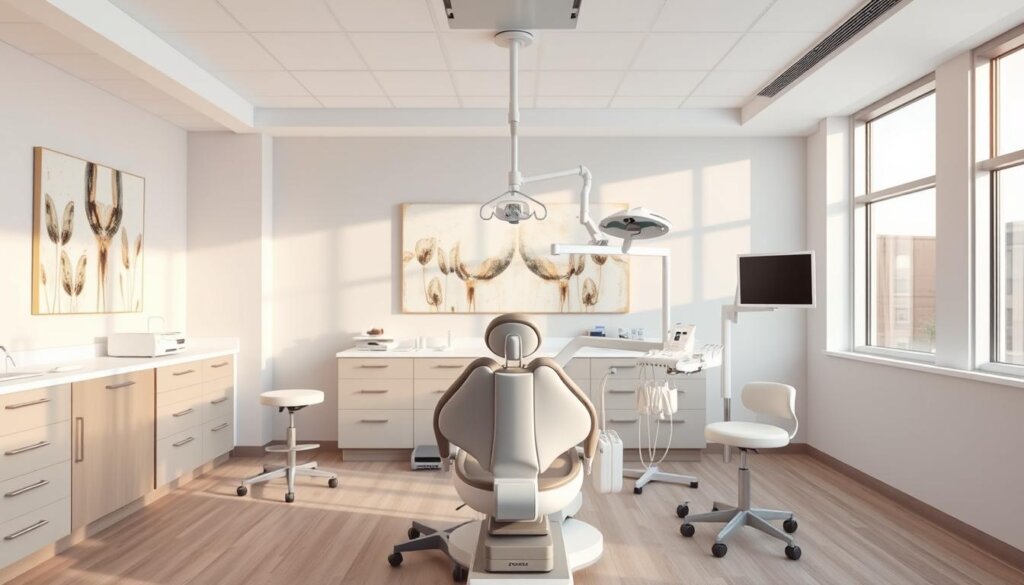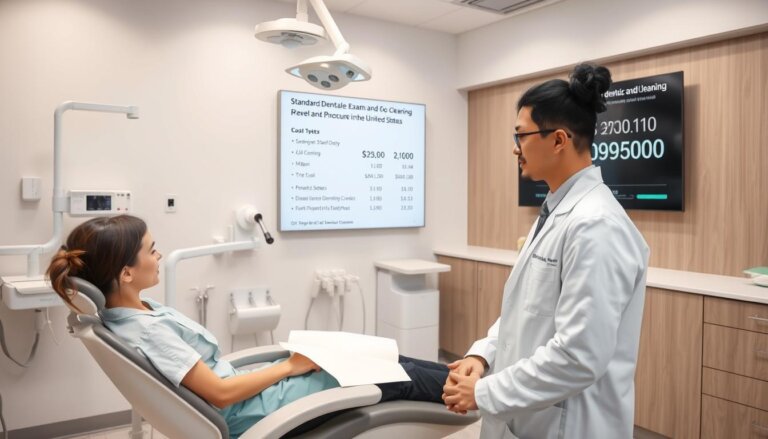Cost of Dental Exam & Cleaning in the US
One in three adults in the United States worries about the cost of dental visits. This worry often leads to missed chances for early detection of problems. These issues can become serious if not caught early.
Prices for tests and cleanings change based on where you live and your insurance. A routine checkup is usually cheaper than urgent care. Knowing these prices helps plan for good oral health in the long run.
Key Takeaways
- Early detection of tooth and gum problems saves patients from larger expenses
- Average costs depend on region, insurance plan, and type of cleaning
- Routine preventive care tends to reduce the need for costly treatments
- Prices for dental exams vary widely from state to state
- Informed decisions about dental services lead to better oral health
Introduction to Dental Exams and Cleanings
Experts say regular checkups are key to catching tooth decay and gum disease early. These visits let dentists see inside your mouth closely. They can then treat problems before they get worse.
A good dental visit includes checking and cleaning. It also includes talking about how to keep your mouth healthy for a long time.
Importance of Regular Dental Care
Going to the dentist often can prevent big problems later. It means you won’t need painful and expensive treatments. At each visit, dentists look closely, use X-rays, and talk about how to keep your teeth clean.
Overview of Dental Procedures
Dentists do many things, like screenings, cleanings, and fixing teeth. Some clean your teeth and make them shiny. Others fill cavities or fix broken teeth. New technology like digital X-rays helps find problems you can’t see.
- Examination of gum health
- Tartar and plaque removal
- Preventive polishing techniques
| Procedure | Purpose |
|---|---|
| Basic Exam | Checks teeth and gum condition |
| Cleaning | Eliminates plaque and surface stains |
| Restoration | Repairs structural damage |
Average Cost of Dental Exams
Dental exam fees can vary a lot. Some clinics charge under $60 for basic checkups. Others might ask for $300 or more. This difference comes from many factors like location, equipment, and patient health.
Factors Influencing Exam Costs
Dental clinics set their fees based on several things. Important factors include:
- The level of diagnostic imaging or lab work needed
- The dental team’s expertise and credentials
- The complexity of the patient’s oral health
Regional Price Variations
Places with higher costs of living have pricier dental services. Smaller towns might be more affordable. Urban areas often have advanced technology and staff, leading to higher prices.
Insurance Coverage Impact
Dental plans can help a lot with exam costs. Many plans cover preventive checkups fully or at a lower rate. This encourages regular dental visits. Those without insurance might find payment plans or discounts through dental programs.
Average Cost of Dental Cleanings
Many dental experts say routine cleanings are key for healthy gums and teeth. Regular visits can stop severe buildup that could harm gums and teeth.
Basic Cleaning vs. Deep Cleaning
Basic cleaning, or prophylaxis, removes plaque and tartar above the gumline. Deep cleaning, or scaling and root planing, targets buildup below the gumline. Some may need sedation or local anesthesia for deeper cleanings.
Prices go up if more anesthetic or special tools are needed.
Factors Affecting Cleaning Costs
Several things can change how much you pay for cleanings. These include:
- How bad the plaque and gum issues are
- The time and skill needed
- The technology used, like ultrasonic scalers
- The depth of root planing needed
Preventive care is important because it can save you money in the long run.
Breakdown of Costs by State
This section talks about how location affects dental exam costs. Places with more people might charge more, while smaller towns often have lower prices. These differences come from local economies, the skill of dentists, and the technology used.
Dental Exam Costs in California
In big cities, dental prices can vary a lot. Offices with the latest tech might cost more. Some places in California charge up to $150 for a dental exam, due to high costs and skilled staff.
Dental Exam Costs in Texas
In Texas, prices are generally more affordable. Big cities like Dallas and Houston might charge up to $140. But, many smaller towns offer lower prices, making dental care accessible to more people.
Dental Exam Costs in New York
In New York, costs are often higher. Major hospitals and private clinics can charge over $160. This is because of high rent and advanced diagnostic tools. The demand in New York also plays a big role in these prices.
| State | Approx. Fee Range | Influencing Factor |
|---|---|---|
| California | $90–$150 | High urban overhead |
| Texas | $80–$140 | Market competition |
| New York | $100–$160 | Specialty services |
What to Expect During a Dental Exam
A standard visit includes a detailed review of oral health. It also helps catch problems early. Practitioners check teeth, gums, and soft tissues. They gather important info for care that fits you.
This process can find hidden cavities and check gum depth. It helps spot early signs of infection or disease. Some clinics share these findings with patients right away. This ensures clarity and reassurance.
Typical Procedures Involved
Teams often follow structured steps for thorough evaluations. These may include:
- Visual inspection of enamel and gums
- Gentle manual probing for decay
- Review of existing restorations
Common Tools and Technologies Used
Digital X-rays detect issues below the surface. They show subgingival decay or bone loss. Clinics with Dentsply Sirona or KaVo imaging systems may use advanced cone-beam CT scans.
These extra measures can raise initial costs. But they contribute a lot to accurate diagnoses. The result is a reliable overview of oral health. This helps professionals recommend effective treatment plans.
What to Expect During a Dental Cleaning
A routine visit often starts with a quick check of your mouth and gums. The hygienist looks for loose plaque and gets ready with special tools. This helps keep your teeth safe from decay and supports your oral health for the long term.
Types of Cleanings Offered
For light tartar buildup, a prophylaxis is used. It polishes and removes plaque. But if gum disease is more serious, scaling and root planing might be needed. This involves using ultrasonic tools to clean deep areas around the tooth roots.
Patients might feel some gum soreness or sensitivity after this. This is because of the extensive cleaning.
Aftercare Tips for Patients
After the cleaning, gentle brushing and antibacterial mouthwash are key. Start with softer foods if your gums are sore. It’s also smart to book a follow-up to check on healing and improve your home care routine.
Being careful with aftercare can help avoid more deep cleanings. This saves money and keeps your mouth healthy.
Insurance Coverage for Dental Exams and Cleanings
Many people use dental insurance to help pay for preventive care. Companies like Delta Dental, Cigna, and Aetna offer benefits that encourage regular dental visits. This can lead to better oral health in the long run.
Dentists advise checking your insurance details. Coverage levels and the network of providers can vary. Knowing this helps you make informed choices about your dental care.
Understanding Dental Insurance Plans
Dental insurance plans come in different types. Some require you to see a specific dentist, while others allow more flexibility. Here are the main types:
- Preventive: Routine exams, cleaning, and basic X-rays
- Basic: Fillings and simple extractions
- Major: Crowns, surgical treatments, and root canals
What Services Are Typically Covered
Preventive care usually gets the highest coverage. Regular cleanings and exams help catch problems early. Dentists say that using these benefits can prevent more serious issues and keep your teeth healthy.
Payment Options for Dental Services
Many patients look for ways to handle dental costs. Clinics work with banks or have their own plans. This makes treatments like checkups and periodontal care more affordable.
Financing Plans Offered by Dentists
Some dentists offer plans with no interest. These plans break down costs into smaller parts. Others team up with credit providers for longer payment terms.
This helps patients manage the cost of cleanings and more complex treatments.
Use of Health Savings Accounts (HSAs)
Many employers offer HSAs as part of their benefits. These accounts can help pay for dental care. By planning ahead, people can keep costs down and support their oral health.
Cost of Dental Exams and Cleanings Without Insurance
Many people struggle with the cost of dental care. Yet, regular checkups are key to keeping teeth healthy. Finding ways to make these visits affordable is important for everyone’s smile.
Finding Affordable Dental Care
Sliding scale fees can make dental visits more affordable. Dental schools often offer cheap cleanings and exams. This helps both the patient and the students.
Low-interest payment plans can also ease the financial burden. This way, you can get the care you need without breaking the bank.
- Discount plans for routine services
- Free or low-cost treatments from nonprofit organizations
- Flexible scheduling to spread out fees
Community Dental Clinics and Resources
Local health departments work with community clinics. These clinics offer early counseling and basic exams at low cost. You can find them by contacting your local health office or checking state websites.
Nonprofit dental programs also help. They offer urgent and preventive care. This ensures everyone can keep their teeth clean and healthy.
Importance of Preventive Care
Preventive care keeps dental problems at bay and helps keep smiles healthy. Regular checkups catch small issues early, stopping them from becoming big problems. Simple habits like brushing daily and regular check-ups greatly improve oral health over time.
Long-Term Cost Savings
Preventive care saves money in the long run. Early treatment of cavities means smaller fillings instead of big ones. Regular cleanings and check-ups also prevent costly, time-consuming treatments.
- Routine exams detect early decay and gum inflammation.
- Timely interventions reduce the likelihood of root canal therapy.
- Consistent care curbs the chance of extensive periodontal procedures.
Health Implications of Neglected Dental Care
Ignoring dental care can lead to serious problems like infections or abscesses. These can harm overall health. Research shows that poor oral health can also increase risks for heart disease and diabetes. Staying committed to preventive care is key to maintaining good health and a strong smile.
Additional Costs Related to Dental Care
Regular checkups can uncover issues that go beyond basic care. Some people face extra costs for detailed diagnostic methods or specific treatments. Planning for these expenses can avoid sudden financial stress.
New technology helps diagnose complex oral health problems. Tools like panoramic X-rays or cone-beam CT scans are used to find decay, bone loss, or hidden infections. Each tool has its own price, and clinics usually explain the costs clearly.
X-rays and Other Diagnostic Tools
Dental imaging options include:
- Panoramic radiographs for a wide view
- Intraoral X-rays for focused views
- Specialized scans for detailed images
Potential Need for Follow-Up Treatments
Advanced problems might need fillings, root canal therapy, or periodontal care. Early detection can prevent more serious issues. Investing in thorough evaluations is key for good oral health and financial stability.
Tips for Reducing Dental Care Costs
Many people want to save money on dental care without sacrificing their oral health. Regular visits can catch problems early. This helps keep costs down and teeth strong.
Regular Visit Schedule Recommendations
Dentists usually recommend visits every six months. At places like Aspen Dental, they might adjust this based on your history or risk. Regular cleanings remove plaque and catch gum issues early.
This helps avoid big bills later on.
Promotions and Discounts from Dentists
Clinics sometimes offer deals on preventive care or whitening. Membership programs can cover exams and cleanings for a yearly fee. Some offices also give loyalty rewards or seasonal discounts.
Looking into these can make dental care more affordable without sacrificing quality.
Conclusion
This article gave insight into dental exam and cleaning costs in the U.S. It talked about possible fees, insurance coverage, and managing costs. Planning ahead can lead to healthier smiles and avoid big dental bills.
Summary of Key Cost Points
Many clinics offer clear prices for exams and cleanings. Costs vary by state, and insurance can help lower costs. Affordable options and payment plans are available too.
Encouragement for Routine Dental Visits
Early detection is key to avoiding expensive oral health issues. Preventive care, like deep cleanings, fights tooth decay and gum disease. Will readers take steps to protect their smiles? Scheduling regular checkups and cleanings is a smart move to stay ahead of dental problems.



